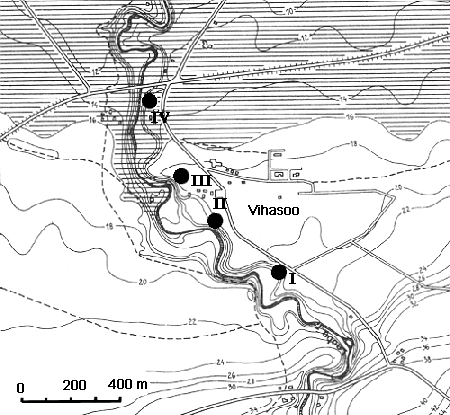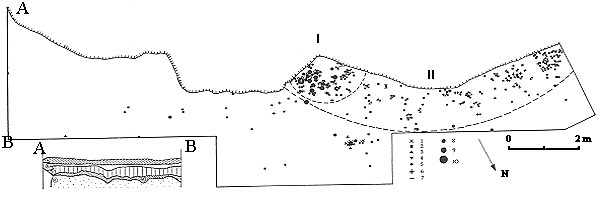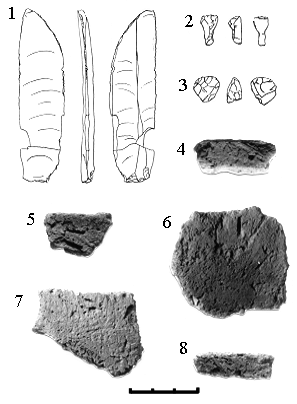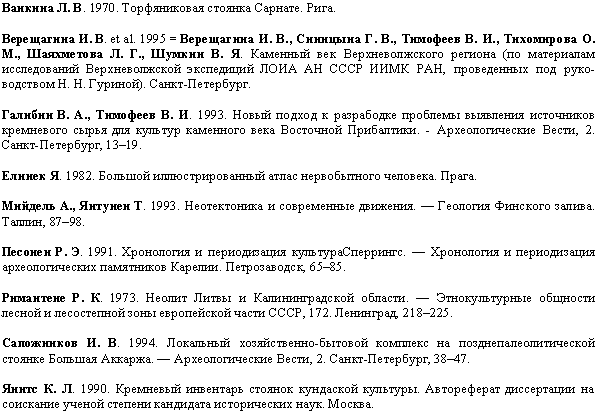EXCAVATIONS OF THE STONE AGE SITE AT VIHASOO III 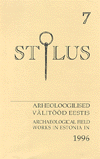
Aivar KRIISKA Tartu Ülikool
(University of Tartu), Lossi 3, EE-2400
Published: Arheoloogilised välitööd Eestis 1996. Stilus, 7, 1997,
19–28.
In spring 1995, Valter Lang and Gurly Vedru discovered three Stone Age sites (I–III) in Vihasoo, North Estonia. During an expedition in May of the same year, one more site (IV) was discovered, and trial excavations were carried out on sites I (conducted by V. Lang) and III (conducted by A. Kriiska) (Lang, 1995). For site III, a trial pit of 2.5 sq.m. was dug. It appeared that the site had been almost destroyed by the collapse of a bank. Even in places where the cultural layer was preserved, the bank was liable to collapse further. Considering this, rescue excavations were carried out, by the author, on an area of 42 sq.m., lasting from June 7th to July 5th, 1996. The work was financed by the Central Board of Antiquities.
Site III of Vihasoo is situated on the right bank of the Loobu River, on a high ridge, ca. 19 m above the present sea level. The preserved cultural layer lies in a narrow strip, on a relatively flat verge of a steep bank. Stratigraphically, five layers could be determined (Fig. 2): a) fresh humus, up to 20 cm thick, b) humus up to 10 cm thick, c) light grey sandy layer, up to 30 cm thick, d) reddish-brown ortstein, 15 cm thick, and below that, e) yellowish layer of illuvic horizon. Finds were located in layers c–e, in the soil 45 cm thick.
Fig. 2. Plan of the Vihasoo excavations. 1 – fragment of a polishing stone; 2 – quartz flake, blade, lump; 3 – quartz scraper; 4 – flint scraper; 5 – knife of a flint blade; 6 – stone flake, scraper; 7 – flint flake, blade; 8 – 1 potsherd; 9 – 2–10 potsherds; 10 – more than 10 potsherds; a – fresh humus (A/0); b – humus (A/l); c – sandy layer (A/2); d – ortstein (A/2 B); e – illuvic horizon (B).
Immovable objects were not discovered in the excavations, but the finds were rather clearly concentrated in two areas (Fig. 2). The first of them (I) was located in the central part of the excavation. 83.5 % of the potsherds, found in situ, came from this 2 m diameter area. The other (II) area (which in a wider context enfolds area I) was located in the central and WNW parts of the excavation and measured ca. 8 m in diameter. It is possible that the II area of finds, especially its bow-shaped form, refers to the location of some aboveground dwelling. The concentration of finds in the remains of dwellings has been recorded in different parts of the world since the Early Palaeolithic (see Elinek, 1982; Sapozhnikov 1994, 42; Vankina, 1970). The smaller concentration area of finds (I) in its folds, could be interpreted as the surroundings of a fireplace. This opinion is supported by analogous finds from several other sites, e.g. the investigations at the Kõpu I and Riigiküla IV Early Neolithic sites, established clear connection between pottery and fireplaces (Kriiska, 1995 a; Kriiska, 1996 a). During the inventory trips and
excavations, 561 stone finds were obtained from the Vihasoo III site. Four hundred and
seventy five (84.7 %) of them are of quartz, 17 (3.0 %) of flint, 12 (2.2
%) of sandstone, 2 (0.4 %) of quartzite and 55 (9.8 %) of different crystalline
rocks. The majority of the finds are flakes; blades are less numerous.
Of the blades, 12 are of quartz (2.3 % of quartz finds) and 2 are of flint
(11.8 % of the flint finds). Eleven of the quartz blades are single-ridged
and one is without a ridge. Their lengths vary from 0.4–1.5 cm
and thickness varies from 0.2–0.8 cm. Flint composes one small
(1.5 x 0.7 x 0.3 cm) single-ridged blade and one large (7.8 x 2.0 x 0.6
cm) knife of a blade (Fig. 3, 1). Eleven pieces of sandstone can
be interpreted as polishing stones.
Fourteen artefacts of secondary processing
were found (2.5 % of the total). They are all scrapers. Eleven of them
(78.6 %) are of quartz, two (14.3 %) of flint and one (7.1 %) of stone.
Both flint ones are microscrapers made of flake. One of them, segmental
in form, is an end scraper (Fig. 3, 2), the other, triangular shaped,
is a side-scraper (Fig. 3, 3). The stone scraper is made of flake
and has a wide and wavy edge. The quartz scrapers (Fig. 4) are made of
flakes (6) or blade-shaped flakes (5) and are quadrangular (4), triangular
(2), segmental (1), square (1) or irregular (2) in form. Eight of them
are side- and three end-scrapers, one of the latter is a high scraper.
In 9 cases they are single-edged and in 2 cases double-edged. The edges
are wide (6) or narrow (5), straight (5), concave (5) or convex (3). The
quartz scrapers are 1.7–4.8 cm long, 1.0–3.5 cm wide and 0.4–1.3
cm thick. 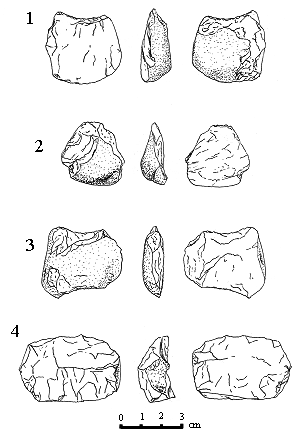
Fig. 4. Quartz scrapers from the Vihasoo III site (AI 6038:20, 16, 67, 56). One hundred and thirteen potsherds
were found altogether (Fig. 3, 4–8). The number of vessels
cannot be exactly determined; however, by the visual estimation there appear
to be only a few. Mostly they are made of clay with organic, presumably
plant admixture (101, i.e. 89.4 %). Only in a few sherds can sand (2, i.e.
1.8 %), stone rubble (2, i.e. 1.8 %) or mineral and organic admixture (8,
i.e. 7.1 %) be traced in the composition of the clay. The last group does
not differ from the rest by other parameters (i.e. the moulding technique,
the shape of connecting surfaces, thickness of walls and the treatment
of surfaces).
The vessels were moulded by band
technique. In 97 cases, the type of the band was distinguishable. Ninety-six
of these (99 %) belonged to the so-called U-type (convex-concave) and one
to the H-type (straight-straight) connecting surfaces. The greatest number
of distinguishable bands in one sherd was 6. Eighty-three bands had both
connecting surfaces preserved so that the width of the band could be measured.
This varied from 3 to 11 mm, 7 mm on average. Only in 10 cases (12.0 %)
did the width of the band exceed 10 mm. The width of the bands in any one
sherd varied by 3 mm at the most.
The shape of the vessels was evidently
conical, with a tapering bottom. This is indicated by one bottom sherd
and one sherd from near the bottom. The thickness of the walls, and the
curves of the sherds, indicate that the size of the vessels was medium,
according to Stone Age standards (Kriiska, 1995 b). The maximum thickness
of the wall could be determined for 71 sherds. This varied from 4 to 11
mm, the average being 7.5 mm. The treatment of the surfaces could be determined
in 142 cases. Ninety-one (64.1 %) of the surfaces were smoothed (outer
surfaces in 48 and inner surfaces in 43 cases) and 51 sherds (35.9 %) were
striated (inner surface in 28 and outer surface in 23 cases). Ornamentation
is completely absent, except for one sherd which has two oblong impressions
on the surface (Fig. 3, 5). As for this sherd we cannot be sure
whether this is true ornamentation or an accidental pore, which has emerged
from burning-out of the organic admixture.
The cultural relations of the find
complex can be determined, first of all, on the basis of pottery. The dominating
organic admixture in the clay dough of the vessels, the narrow bands with
U-shaped connecting surfaces used for moulding, the conical shape, the
tapering bottoms and medium thickness of the walls of the vessels, the
treatment of surfaces, and the absence/scarceness of ornamentation all
allow us to connect this pottery with the pottery of the narva type and
thus, the whole complex with the Narva culture (compare Jaanits et al.,
1982, 63–66; Kriiska 1995 b, 65–75). Similar to most
coastal settlements of the Kunda-Narva culture in Estonia (Kriiska, 1996
b; Suuroja, 1996, 32), the material used for stone implements in the Vihasoo
III settlement was mostly quartz. Typologically, their most obvious common
trait appears to be the occurrence of concave-edged quartz scrapers.
A rare find, in the context of Estonian
Narva culture, was a knife of a long flint blade with a curved end (Fig.
3, 1). A few longer flint blades and knives have been found from
the Kääpa site of the Narva culture (Jaanits, 1968, 10, fig.
6), but these are not similar to the Vihasoo knife, neither by shape nor
by flint material. The rest of the flint finds of the Vihasoo III site
are whitish or dark grey calcedony of relatively low quality, which by
visual determination originate from limestone deposits and are evidently
of local origin. However, the knife-shaped blade is made of black translucent
calcedony from chalk deposits (cretaceous system). The origin of the rock
cannot be exactly determined. Similar calcedony occurs naturally in South
Lithuania and Byelorussia, from where the flint of Pulli is deemed to originate
(Jaanits & Jaanits, 1978, 61–62), but also in the South of
Scandinavia. The nearest areas where large flint blades and knives occur,
in great numbers, in Early Neolithic material, are the areas of the Neman
culture in South Lithuania (Rimantiene, 1973, 219) and the monuments, with
pottery of the so-called cottchishchenski type, on the upper reaches of
the Volga River (Vereschagina et al., 1995). To some extent the knives
of flint blades have also been found from the sites of the Early Comb Ware
of Karelia (Pesonen, 1991, 71). Late Mesolithic and Early Neolithic periods
have been considered, reasonably, to be the periods founded upon local
raw materials, unlike the Early Mesolithic or Middle Neolithic which provide
an abundance of imported flint (Jaanits, 1990, 31; Galibin & Timofeev,
1993, 13). However, Neolithic people did not live in isolation either.
Contacts beyond the limits of the cultural area are indicated, evidently,
by the Vihasoo flint find, but also by the unique potsherd, discrepant
in the context of pottery of the Narva culture, from the Riigiküla
IV settlement (Kriiska, 1996 a, 415).
In the period of its existence, the
Vihasoo III settlement was evidently located at the mouth of the Loobu
River (Fig. 1). Since the other settlements have not yet been identified,
neither archaeologically-culturally, nor temporally, nothing can be predicted
about the regional changes in settlement. As a working hypothesis, it can
be presumed that the settlement moved after the transgressing sea and that
the settlement sites mark the estuaries of the ancient river.
The absolute age of the III settlement
of Vihasoo can only be determined indirectly since the radiocarbon dates
obtained from charcoal samples, gathered from the layer of finds, were
clearly wrong. Evidently the samples contained, accidentally, some charcoal
fragments of later origin (the results obtained are supplemented to the
excavation reports in the archives of the Institute of History). At the
moment the only starting points are the comparison of the Vihasoo find
complex with the finds from the geographically dated monuments, and the
coastal transfer chronology. As already stated, Vihasoo was a settlement
from the Narva culture. The appearance of this culture on the coast can
be presumed to be ca. 5000 BC (cal) on the basis of the 14C
datings from Riigiküla (Kriiska, 1996 a). The latest datings from
coastal settlements of the Narva culture are about 1000 years younger (Kriiska,
1995 b). Assuming the population of Vihasoo to have been water-bound, and
considering the maximal possible rise in water level by storm waves to
be 2–3 m (Järvekülg & Veldre, 1963, 66), we may
suppose that the sea level in the period of existence of the III settlement
was about 16–17 m higher than nowadays. At present, the land rise
is estimated to be ca. 2.5 mm per year (Miidel & Jantunen, 1992, fig.
38). On this basis the coastline of the period of the III settlement can
be dated to ca. 4800–4600 BC. Since the land rise could have been
somewhat faster in the past, the calculated age may be a little older than
the actual one.
At the present stage of investigation,
it is difficult to comment upon the economic background of the population
of Vihasoo. A wide-ranged hunting-gathering economy, favoured by the location
in the estuary, was evidently an important part. Of the five animal bone
fragments found, only one is determinable. The osteologist, Lembi Lõugas,
asserts that it belongs to a seal. A gathering economy is indicated by
some nutshells found in the cultural layer. References Jaanits, L. 1968. Die
frühneolitische Kultur in Estland. — Congressus
Secundus Internationalis Fenno-Ugristarum Helsingiae habitus 23.–28.
07.1965. Pars 2. Helsinki, 12–25.
Jaanits, L. &
Jaanits, K. 1978. Ausgrabungender frühmesolithischen Siedlung
von Pulli. — ENSV TA Toim. Ühisk., 27, 1, 56–63.
Jaanits, L., Laul, S., Lõugas, V., Tõnisson, E. 1982. Eesti
esiajalugu. Tallinn.
Järvekülg, A. & Veldre, I. 1963. Elu Läänemeres.
Tallinn.
Kriiska, A.
1995 a. Archaeologische Ausgrabungen auf dem Standort der ehemaligen Steinzeitsiedlung
Kõpu I (Ristipõllu). — Proc. Estonian Acad. Sci.
Humanities and Social Sciences, 44, 4, 410–416.
Kriiska, A.
1995 b. Narva jõe alamjooksu ala neoliitiline keraamika. — Muinasaja teadus,
3. Eesti arheoloogia historiograafilisi, teoreetilisi
ja kultuuriajaloolisi aspekte. Tallinn, 54–115.
Kriiska, A.
1996 a. Archaeological excavations in Neolithic site of Riigiküla
IV. — Proc. Estonian Acad. Sci. Humanities and Social Sciences,
45, 4, 410–419.
Kriiska, A.
1996 b. Arheoloogilised välitööd Riigiküla kiviaja
asulakohtadel (Vaivara khk.) 12. 06.–7. 07. 1995. Manuscript
in the Institute of History, Tallinn.
Kriiska, A.
1996 c. Viron rannikkoaluen asutus ja pyyntikulttuuri erikoistuminen kivikaudella.
— Muinaistutkija. Nr. 4, 1–6.
Lang, V. 1995.
Aruanne inspektsioonist Vihasoo–Ilumäe piirkonda ning proovikaevamistest
Vihasoo I kiviaja asulakohal. Manuscript in the Institute of History, Tallinn.
Suuroja, T.
1996. Eesti põhjaranniku mesoliitiliste ja neoliitiliste asulakohtade
kiviaines. — Stilus, 6. Reports of the Estonian Archaeological
Society, Tallinn, 30–36.
ARHEOLOOGILISED KAEVAMISED VIHASOO III KIVIAJA ASULAKOHAL Aivar KRIISKA 1995. aasta kevadel leidsid Gurly
Vedru, Valter Lang ja Aivar Kriiska Põhja-Eestis Vihasoos neli kiviaja
asulakohta (joon. 1). Samal aastal tehti proovikaevamisi I (V. Lang) ja
III (A. Kriiska) asulakohal. III asula proovikaevand näitas, et kaldavaringuga
oli asulakoht peaaegu hävinud. Seal, kus kultuurkihti oli veel säilinud,
oli kallas varisemisohtlik. Sealsamas toimusidki 1996. aastal päästekaevamised.
Töid finantseeris Riigi Muinsuskaitseamet.
Vihasoo III asulakoht asub Loobu
jõe paremkaldal, tänapäevasest merepinnast u. 19 m kõrgusel
seljakul. Säilinud kultuurkiht paiknes kitsa ribana kaldajärsakul.
Kokku uuriti 45,5 m² suurust ala. Stratigraafiliselt eristus viis
kihti. Leide saadi kuni 45 cm paksusest pinnasest.
Leiud kontsentreerusid võrdlemisi
selgelt kahel alal (joon. 2). Neist esimene (I) paiknes kaevandi keskosas.
Sealt, u. 2 m läbimõõduga alalt leiti 83.5 % in situ
paiknenud savinõukildudest. Teine (II), mis laiemalt vaadatuna hõ1mas
ka esimest, oli u. 8 m läbimõõduga. Pole võimatu,
et II leiuala ja selle kaarjas kuju osutab maapealse elamu asukohale. Leidude
väiksemat kontsentratsiooni selle sees võib tõ1gendada
koldekoha lähiümbrusena.
Vihasoo III asulakohalt on inspektsioonide
ja väljakaevamistega leitud ühtekokku 561 kivileidu. Neist 475
on kvartsist, 17 tulekivist, 12 liivakivist, 2 kvartsiidist ja 55 mitmesugustest
kristalliinsetest kivimitest. Suurema osa moodustavad killud, vähem
on laaste. Laastudest on 12 kvartsist ja 2 tulekivist. Kvartslaastudest
11 on üheharjalised ja 1 harjata. Tulekivist on üks väike
üheharjaline laast ja üks suur laastust nuga (joon. 3, 1).
Erinevalt teistest Vihasoo III asula tulekivileidudest on see valmistatud
läbikumavast mustast kriidilademe kaltsedonist. Looduslikult esineb
sellist tulekivi näiteks Lõuna-Leedus, Valgevenes, aga ka Lõuna-Skandinaavias.
Teisese töötlusega 14 eset
on kõik kõõvitsad. Neist 11 on kvartsist, 2 tulekivist
ja 1 kivist. Mõlemad tulekivist eksemplarid on killust valmistatud
mikrokõõvitsad. Üks, segmendilise kujuga, on ots- (joon.
3, 2) ja teine, kolmnurkne, on külgteraga (joon. 3, 3).
Kivikillust kõõvits on laia lainelise teraga. Kvartsist eksemplarid
(joon. 4) on valmistatud killust või laastutaolisest killust ning
on ristküliku, kolmnurga, segmendi, ruudu või ebakorrapärase
kujuga. Kaheksa neist on külg- ja 3 otskõõvitsad; viimastest
on üks kõrgkõõvits.
Savinõukilde leiti kokku 113
(joon. 3, 4–8). Nõude arvu ei ole võimalik
nende järgi täpselt määrata, kuid arvatavalt on tegemist
vaid mõne nõuga. Keraamika on tehtud peamiselt orgaanika
lisandiga, arvatavalt taimse massiga segatud savist; üksikjuhtudel
on koostises liiva, kivipurdu või mineraalset ja orgaanilist lisandit.
Nõud on vormitud linttehnikas
kitsaste 3–11 mm laiuste, peamiselt (99 %) U-tüüpi ühenduspindadega
lintidena. Seinapaksus varieerub 4–11 mm. Savinõukillud
on silutud (65 %) Vihasoo II asula kuulub Narva kultuuri
ja rannasiirde järgi võib selle oletamisi dateerida päikesekalendri
süsteemis 5. aastatuhande esimesse poolde e.Kr. Eksisteerimise perioodil
paiknes inimasustus tõenäoliselt merre suubuva Loobu jõe
suudmes. Vihasoo asustuse majanduslikust tagamaast saadi vaid vähest
informatsiooni. Leitud viiest luukillust kuulub üks Lembi Lõugase
määrangul hülgele. Kultuurkihist saadi ka mõned sarapuupähkli
koored. |
